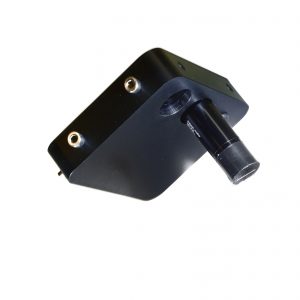Adjacent Exchange in 23ms
Fast Filter Wheel
 Highlights
Highlights
- Twofold speed improvement over the state of the art
- Close integration of the mechanical, electrical, and control subsystems
- Robust, reliable performance
Background
Excitation and emission wavelength selection and light path separation in fluorescence microscopes happens at the intersection of the illuminating beam and the magnified-image-carrying beam inside a cube that holds a set of three filters. Each filter triplet facilitates visualization of biochemical structures labeled with a single fluorescent protein, a number of cubes can be used in sequence to obtain a multi-channel representation of an appropriately prepared specimen for additional insight. While suitable for slowly changing and fixed observations, this approach is not adequate for many processes in live cells that evolve on time scales that require faster wavelength switching that what is achievable with a standard fluorescence cube turret. In these situations, a multi-band light-separating dichroic filter held in a filter cube is used in conjunction with a fast wavelength switching light source and multiple single-band emission filters mounted in a high speed filter wheel. With 20-30ms adjacent filter exchange, this solution enables an order of magnitude faster acquisition than stock cube turrets and integrates conveniently with existing microscopes. For even faster switching, a multi-band emission filter or an image-splitting device can be used at the cost of reduced optical performance.
Approach
 The objective of this project was to eliminate the dynamic performance compromises associated with most commercially available fast filter wheels. To achieve a two-fold speed improvement over the state of the art, close integration of mechanical, electrical, and control system design was critical. First, a light-weight wheel was designed and synchronously coupled to a high-power brushless servo motor in a maximum power transfer configuration. Brushless servo motors offer a performance advantage over easier-to-control stepper motors of similar size, while providing more robust operation inherent from continuous wheel position evaluation necessary for correct feedback motion control. In order to optimize the performance of the servo drive system, a custom electronics board was designed to specifically complement the motor and load. This circuit board, aside from handling the power delivery to the motor, also facilitates the execution of the control algorithm, monitoring of the state of the device, and communication and synchronization with other devices. Central to the entire design, the control system continuously monitors the state of the plant and adjusts the torque generated by the motor, such that peak performance is achieved under a range of operating conditions. The system is specifically designed for robustness under varying payload such that the same dynamic performance is maintained regardless of the number of filters loaded in the wheel. A special software tool was designed to efficiently tune the parameters of the embedded control system, evaluate different control laws, and validate the overall performance of the product. The resulting system is especially well suited for hardware-synchronized installations intended for the most demanding imaging requirements.
The objective of this project was to eliminate the dynamic performance compromises associated with most commercially available fast filter wheels. To achieve a two-fold speed improvement over the state of the art, close integration of mechanical, electrical, and control system design was critical. First, a light-weight wheel was designed and synchronously coupled to a high-power brushless servo motor in a maximum power transfer configuration. Brushless servo motors offer a performance advantage over easier-to-control stepper motors of similar size, while providing more robust operation inherent from continuous wheel position evaluation necessary for correct feedback motion control. In order to optimize the performance of the servo drive system, a custom electronics board was designed to specifically complement the motor and load. This circuit board, aside from handling the power delivery to the motor, also facilitates the execution of the control algorithm, monitoring of the state of the device, and communication and synchronization with other devices. Central to the entire design, the control system continuously monitors the state of the plant and adjusts the torque generated by the motor, such that peak performance is achieved under a range of operating conditions. The system is specifically designed for robustness under varying payload such that the same dynamic performance is maintained regardless of the number of filters loaded in the wheel. A special software tool was designed to efficiently tune the parameters of the embedded control system, evaluate different control laws, and validate the overall performance of the product. The resulting system is especially well suited for hardware-synchronized installations intended for the most demanding imaging requirements.
Specifications
| Filter Count | 6 (10) |
| Adjacent Filter Switch | 23ms (30ms) |
| Filter size | ø25mm | ø1″ |
| Interface | Digital trigger | RS-232 |
| Housing Size | 108mm x 152mm (159 mm x 184 mm) |
| Housing Thickness | 25mm (114 mm with motor) |
| Weight | 1.2kg (1.5kg) |

